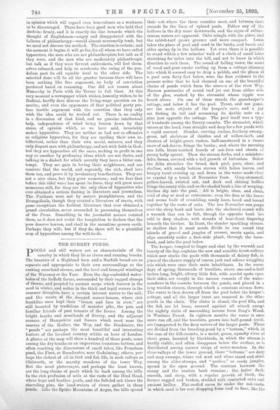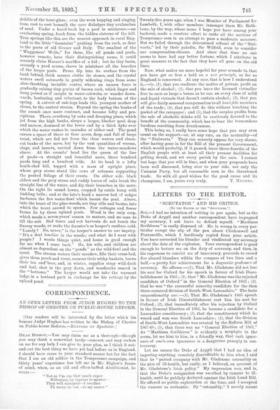THE SURREY PONDS.
POOLS and still waters are as characteristic of the country in which they lie as' rivers and running brooks. The beauties of a Highland tarn and a Norfolk broad are as separate and appropriate to their own surroundings as the rushing moorland stream, and the level and tranquil windings of the Waveney or the 'rare. Even the clay-embedded water- holes of the Suffolk farms, surrounded by their ragged clumps of thorns, and peopled by ancient carps which burrow in the mud in winter, and welter in the thick and tepid waters in the summer droughts, have a certain interest native to the soil; and the moats of the decayed manor-houses, where rich franklins once kept their "bream and lace in stew," are still haunted by traditions of monster pike, the pets and familiar friends of past tenants of the farms. Among the bright, heaths and moorlands of Surrey, and the adjacent corners of Hampshire and Sussex which meet near the sources of the Bother, the Wey, and the Deadwater, the " ponds " are perhaps the most beautiful and interesting feature of the loveliest country within an hour of London. A glance at the map will show a hundred of these pools, some among, the dry heaths on an impervious ironstone bottom, and often reaching the dimensions of small lakes, like Frensham pond, the Fleet, or Broad water, near Godalming ; others, per- haps the richest of all in bird and fish life, in such valleys as Chilworth, or the marshy meadows of the lower Wey. But the most picturesque, and perhaps the least known, are the long chains of pools which lie back among the bills. In the rich profusion of soils at the roots of the Hind Head, where hops and heather jostle, and the full-fed oak kisses the starveling pine, the head-waters of rivers gather in these ponds. Like the Spider Mountains of Argos, the hills spread their web where the three counties meet, and between their strands lie the lines of upland pools. Follow any of the hollows in the dry moor downwards, and the signs of subter- ranean waters are apparent. Oaks mingle with the pines, and the rabbit-turf grows greener and more compact. Loam takes the place of peat and sand in the banks, and beech and alder spring tip in the hollows. Yet even there it is possible to stand within a few minutes' walk of a chain of small lakes stretching for miles into the bill, and not to know in which direction to seek them. The sound of falling water, the scent of wood and peat smoke curling up from a cottage chimney into which it seemed easy to drop a pebble, and the gleam of a pool seen forty feet below, were the first evidence to the present writer that he had chanced on one of the beautiful chains of ponds which form the sources of the river Wey. Narrow peninsulas of sound turf jut out from either side of the glen, washed by the streamlet whose ripple was heard above. On one of these stands the gamekeeper's cottage, and below it lies the pool, Trout, and not game, are the main objects of the keeper's care, and a jay sat flirting its tail and screaming its double note on a pine just opposite the cottage. The pool itself was a type of hundreds among the Surrey wombs. The streamlet, which enters at the head, runs straight and deep for a few yards with a rapid current. Slender, curving rushes, feathery swamp- grass, tall skeletons of thistles and of willow-herb, and clusters of bright-green rushes, half-smothered in a russet snow of oak-leaves, fringe the banks ; and where the morning sun falls, blunt-toothed fronds of oak-fern and shoots of young holly sprout. Then the stream forks, and a miniature delta forms, covered with a tall growth of bulrushes. Below the delta stretches the broad, dark pool, pure, clear, and shallow, with sandy bottom strewn with fallen leaves, and hungry trout cruising up and down in' the water made clear as crystal by a touch of November frost. Grey-stemmed, yellow-leaved, twisted oak, and dark and shining hollies fringe the sunny side, and on the shaded bank a line of weeping. birches dip into the pool. All is bright, clear, and clean, void of clay or mud or rottenness ; even the dam at the lower end seems built of crumbling, sandy loam, laced and bound together by the roots of oaks. The low November sun peeps over the steep bank and beats into the sheltered womb with a warmth that can be felt, though the opposite bank lies cold in deep shadow, with streaks of hoar-frost lingering beneath the birches. In front, the slender sparkling stream, so shallow that it must needs divide to run round tiny islands of gravel and jungles of creases, meets again, and slips smoothly under a foot-wide plank, through the loam- bank, and into the pool below.
The keeper, tempted to linger and chat by the warmth and beauty of the day, explains the new and sensible trout-culture which now stocks the pools with thousands of dainty fish, in place of the chance supply of coarse jack and odious wriggling eels which were once their main inhabitants. In the warm days of spring, thousands of troutlets, about one-and-a-half inches long, bright, silvery little fish, with scarlet spots upon their sides, are caught in the narrow runnels of the water- meadows in the coombs between the ponds, and placed in a long wooden cistern, through which a constant stream flows. The water is then drawn off from the pool below the keeper's cottage, and all the larger trout are removed to the other ponds in the chain. The sluice is closed, the pool fills, and the fish are let loose, secured against all attack except the nightly visits of marauding herons from Stag's Wood, in Woolmer Forest. In eighteen months the water is once more run off, and the troutlets, grown into half-pound trout, are transported to the deep waters of the larger pools. These are divided from the breeding-pond by a " bottom," which, in the case of the hill-coombs, is a moist, green, squashy river of short grass, haunted by blackbirds, in which the stream is hardly visible, and often disappears below the surface, or is distributed among narrow strips of water-meadow. In the river-valleys of the lower ground, these " bottoms " are deep and oozy swamps, where red mud and slime stand and stink among the alder-stumps, and "quakes," or reedy jungles, spread in the open ground. The contrast between the sunny and the sunless bank remains ; the latter dark, smooth, and steep, with a regular growth of birch, the former rugged and broken, studded with contorted oaks and ancient hollies. Flat-roofed caves lie under the oak-roots, in which sand is'for ever dropping from roof to floor, like the dribble of the hour-glass ; even the wren hopping and singing from root to root beneath the cave dislodges tiny avalanches of sand. Under a hazel-bush lay a pool in miniature,—an everlasting spring, fresh from the hidden cisterns of the hill. True springs like this are the nearest approach in rural Eng- land to the little " fountains " gushing from the rock, so dear to the poets of old Greece and Italy. The smallest of the Waggoners' Wells," for these, like all ponds and pools, however remote, have their distinguishing name, it could scarcely claim Horace's sacrifice of a kid ; but its tiny basin, scarcely a yard across, shows in miniature all the beauties of the larger pools. Ferns dip into its surface from the bank behind, thick mosses clothe its stones, and the crystal waters swell outwards in gently widening rings from some slow-throbbing invisible centre, where an unseen force is gradually raising tiny grains of brown rock, which linger and hang poised as if caught in water-cobwebs, or wander down- 'wards, hesitating and reluctant, to the leafy bottom of the spring. A culvert of oak-logs leads this youngest mother of rivers, to the central stream. Beyond the spring the banks of the coomb once more contract, and become lofty and pre- cipitous. There, overhung by oaks and drooping pines, which jut from the high banks, sleeps a larger, blacker pool, deep and narrow, dammed at the lower end by a thick dyke over which the water rushes in cascades at either end. The pond covers a space of three or four acres, deep, and full of large trout, which are fed not from the clear waters and clean- cut banks of the mere, but by the vast quantities of worms, slugs, and insects, carried down from the water-meadows above. At the coombs' head lies the queen of the line of pools—a straight and beautiful mere, three hundred yards long and a hundred wide. At its head is a lofty heath-clad hill, topped with a mass of upright pines, whose grey stems stand like rows of columns supporting the peaked foliage of their crests. On either side, black alders and the grey stems and ruddy leaves of oaks break the straight line of the water, and dip their branches in the mere. 'On the right lie sound lawns, cropped by cattle hung with tinkling bells ; and at the lake's head a narrow bed of sedges harbours the few water-fowl which haunt the pool. Above, into the heart of the pine-woods, are tiny rills and basins, into which the trout ascend to spawn. Few cottages and fewer farms lie by these upland pools. Wood is the only crop, which needs a seven-years' season to mature, and no man to till the soil. Bad times and wet harvests do not touch the Surrey woods, or make the forester's or keeper's rooftree cold. " Lonely ? No, never," is the keeper's answer to our inquiry. ." It's a deal lonelier in the woods; and what do I want with people ? I wants things quiet, and home is good enough for me when I come back." He, his wife, and children are .almost as dependent on the " ponds " as the wild-fowl and the trout. The stream waters their meadow, fills their cress-bed, gives them perch and trout, seasons their withy-baskets, brews their tea and"beer, and, in winter, supplies stray wild-duck and teal, shot in the grey dawn, and woodcocks snared in the " bottoms." The keeper would not take the warmest lodge in a lowland park in exchange for his cottage by the 'upland pond.







































 Previous page
Previous page